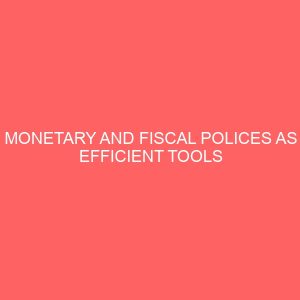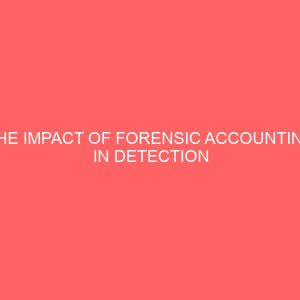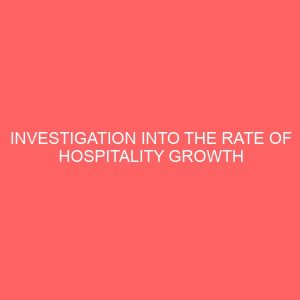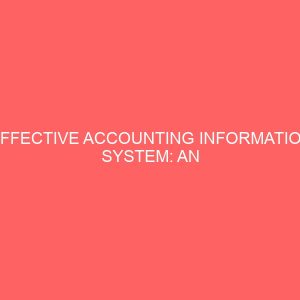Description
THIS RESEARCH WORK IS ON THE AUDITOR AND THE PUBLIC: EXPECTATION GAP
Abstract
This study examines the auditor and the public: Expectation gap. It was carried out to determine if there exists any significant expectation gap in the Nigeria auditing environment. The expectation gap developed from the differing expectations of the function of independent audit between the auditors and the public. The researcher used primary source of data towards obtaining authentic information on the topic. It was discovered that there is a wide expectation gap in Nigeria. The propositions made in the study were evaluated using selected items or statement from the questionnaire. The study concludes that. The audit function is crucial in providing users the assurance about the information provided by management in the financial statements and an attempt to put an end to this wide gap in perception of the users to the auditor’s functions are being carried out in various part of Nigeria. The study recommends among others that the existing duties and responsibilities of auditors should be a clearly defined and widened to include fraud detection.
TABLE OF CONTENTS
Title Page i
Certification ii
Dedication iii
Acknowledgements iv
Abstract v
Table of Contents vi
Chapter One: Introduction 1
1.1 Background to the Study 1
1.2 Statement of Problem 5
1.3 Research Questions 6
1.4 Objective of the Study 6
1.5 Statement of Hypothesis (es) 7
1.6 Significance of the Study 8
1.7 Scope of the Study 9
1.8 Limitations of the Study 10
1.9 Definition of Terms 10
Chapter Two: Review of Related Literature 12
2.1 Introduction 12
2.2 Auditor Competence and the Components of the
Audit Expectation Gap 23
2.3 Audit Reporting 25
2.4 Errors/Fraud Prevention and the Auditor 28
2.5 Liability of an Auditor 29
2.6 Narrowing the Gap 30
Chapter Three: Research Method and Design 35
3.1 Introduction 35
3.2 Research Design 35
3.3 Description of Population of the Study 35
3.4 Sample Size 36
3.5 Sampling Techniques 36
3.6 Sources of Data Collection 36
3.7 Method of Data Presentation 38
3.8 Method of Data Analysis 38
Chapter Four: Data Presentation, Analysis and Hypothesis Testing 41
4.1 Introduction 41
4.2 Presentation of Data 41
4.3 Data Analysis 42
4.4 Hypothesis Testing 45
Chapter Five: Summary of Findings, Conclusion and Recommendations 53
5.1 Introduction 53
5.2 Summary of Findings 53
5.3 Conclusion 54
5.4 Recommendations 55
References 56
CHAPTER ONE
INTRODUCTION
1.1 Background to the Study
Audit expectation gap first came up in 1974 when Liggio discuss the presence of expectation gap due to the fact that since the late 1960, the audit profession had been under attack regarding the quality of its professional performance. He suggested two reasons for this; “a greater willingness to hold others especially professionals–accountable for perceived misconduct and the expectation gap as factor of the levels of expected performance as envisioned by both the independent and by the user of financial statements. The difference between these levels of expected performance is expectation gap.
Then during the 1970s in the united States when the American institute of certified public Accountant (AICPA) set up the commission on Auditor responsibilities (Cohen Commission) to conduct whether a gap exist between what the public expect or need and what the auditor can and should reasonably do, the definition for expectation gap was extended a little. It submitted that the gap which gives rise to criticisms of auditors is that, between what societies expects from auditors and what it perceives it receives from them.
Porter (1993) however argued that the definitions used by Liggio (1974) and the Cohen Commission report were too narrow and they failed to consider the possibility of substandard performance of auditors. She Stats:
The definitions are too narrow in that they do not recognize that auditors may not accomplish “expected performance. It is therefore proposed that the gap, more appropriately entitled “that audit expectation that gap between public’s expectations of auditors and auditors’ perceived performance (PSO)”.
There are also definitions from other researchers: for example: Innes, Alvin and Liggio (2003) define the audit expectations gap as “the difference between what the public expects from auditing profession and what the auditing profession can actually provide”. Humphrey (1999) defines it as “a representation of the feeling that auditors are performing in a manner at variance with the beliefs and desires of these for whose benefit the audit is carried out”. Humphrey (1999) extends his definition to include other issuers such as the adequacy of editing standards and the quality of audit delivery.
Different underlying expectations have been offered for the continuing presence of the explanations problem. Trickier (2002) views the expectation gap as the result of a natural time lag in the auditing profession identifying and responding to continually evolving and expanding public expectation. Other authors argued that it was the consequence of the contradictions in or self regulated that it was the consequence of the contradictions in or self regulated audit system operating with minimal government intervention as evidenced in Hopwood (2000).
A lot has been written about the possibility of an audit expectation gap. Concerns over ambiguities in the roles and responsibilities of auditors have led to the establishment of several government and professional investigation which form an important part of the expectation gap literature. These include the Cohen commission (1987), in the United States, the cross Committer (1977), Greenside Committee (1978), Metcalf Committee (1976), and Tread way Commission (1987); in the United State; the Cross Committee and Greenside Committee (1977) and Mac Donald Commission (1988) in Canada.
A common finding in all these investigation is that there is a gap between audit performance and expectation exists. Due to the growing expectation gap between the auditors and the public, the accounting profession has attempted to narrow, if not eliminate the gap and counteract the negative consequences. Efforts to this end have included the changes in accounting/auditing standard, revising the audit report and conducting official investigation as evidenced in the studies of Pound and Fensome (2003), Chenok (2004), ICAA (2004) and Guy (2008).
According to Fadzly and Ahmed (2004), the audit expectation gap is a critical issue in auditing because of the damage it has brought and continues to bring to the essence of auditing profession.
1.2 Statement of Problem
Research to date on the audit expectation gap indicates that it exists for several reasons. Porter and Gowthropew (2004), for example, have argued that the gap exist due to deficiency in auditor’s performance and auditing standards. Pierce and Kilcommins (2006) argue that the gap exists due to misinterpretations and misunderstanding of the meaning of auditing by the users. These studies suggest that users do not understand the audit functions and role of auditors. Consequently, they have unrealistic expectations of auditors.
Surprisingly, unlike the situation in the private sector, the research into the audit expectations gap in the public sector has received little attention by researchers. To date only Chowdhory and Innes (1998), Pendlebory and Shrieim (2001), have undertaken research investigating the audit expectations gap in the public sector.
Until recently studies of audit expectation in the context of performance audit have only been conducted in developed countries. However, due to the recent collapse of large companies in Nigeria, the existence of expectation gap has been brought to light. Hence, what are the causes of expectation gap in Nigeria?
1.3 Research Questions
1. Is there any significant expectation gap in the Nigeria auditing environment?
2. Could these gaps be identified?
3. Could these gap areas been eliminated?
4. Could these gap be reduced if, cannot be completely eliminated?
5. What are the perception of the auditors and users of audit reports towards the roles and responsibilities
of the auditor?
1.4 Objective of the Study
The broad objective of auditor and the public expectation gap in Nigeria. The specific objectives are;
1. To find out whether there is expectation gap in Nigeria.
2. To ascertain whether the areas of the gap could be identified.
3. To check if the identified areas will make it possible to eliminate the gaps.
4. To check if the expectation gap can be reduced in cases which can not be completely eliminated.
5. To find out the perception of auditor and users of audit reports and the responsibilities of the auditor.
1.5 Statement of Hypotheses
The following null hypotheses were tested in order to provide answers to the aforementioned questions in the aims and objectives.
Hypothesis One
HO: Expectation gap does not exist in Nigeria
HI: Expectation gap exist in Nigeria
Hypothesis Two
HO: There is no significant difference in the perception of respondents groups on existing duties and responsibilities of auditors.
HI: There is significant difference in the perception of respondents groups on existing duties and responsibilities of auditors.
Hypothesis Three
HO: Educating users will not reduce their perception towards auditors.
HI: Educating users will reduce their perception towards auditors.
1.6 Significance of the Study
From the researcher’s point of view, this study potentially contributes to the auditing literature in various ways.
i. It extends the existing knowledge on the audit expectation gap by providing evidence of the nature of audit expectation and their composition in Nigeria.
ii. By examining the nature of performance audit and audit process, using Nigeria as a case study, this study contributes to the literature of performance audit in developing countries. This study demonstrates that the audit institutions of such countries cannot afford to overlook the importance of compatibility with needs of users to the conduct of auditing.
iii. Finally, the finding of this study could provide a useful framework for studding the audit expectation gap in the public sector and be useful to academics and other researchers.
1.7 Scope of the Study
This study examines the auditor and the public expectation gap. Geographically, the study was limited to Benin City and the sample size was limited to 75 potential participants. The study is motivated by the current state of the auditing profession in Nigeria as a result of recent financial scandals Therefore the perception of selected stakeholder were sought tin providing answer to the questions raised in the study. The focus of the research in term of study group includes external auditors, (auditor’s public account and management) and audit beneficiaries (stakeholders and investor).
1.8 Limitations of the Study
In the course of this research, some problems were encountered which include the following:
- Biasness on the respondents.
- Lack of available information to be obtained from the sample firms.
- Some selected firms were used as case study hence if the result is generalized, it may not reflect the true position of other firms due to environmental difference.
1.9 Definition of Terms
Auditing: This is defined as a systematic and independent examination of data, statement, record, operations and performance.
Expectation gap: Is the difference between the effectiveness of audit engagement what users believe and what auditors believes.
Audit competence: It means to be able to apply knowledge and skill to achieve intend result in the financial records.
Audit report: Is a written opinion of an auditor regarding whether an entity’s financial statement present fairly its financial position.
Fraud: This is deliberate deception to secure unfair or unlawful gain.
Fraud prevention: Fraud prevention to be effective in an organization requires a number of contributing elements including an ethical organizational culture, a storing awareness of fraud among employee, suppliers and client on effective internal control framework.
Accountability: This is the obligation of an individual or organization to account for its activities, accept responsibility for them and to disclose the result in transparent manner.








Reviews
There are no reviews yet.